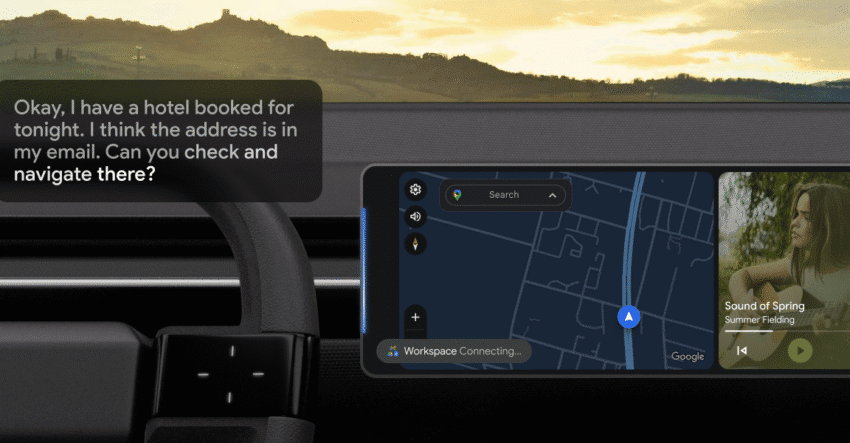
hey google did you upgrade your ai Google has made significant strides in enhancing its Android Auto platform, now integrating advanced AI capabilities to improve user interaction while driving.
hey google did you upgrade your ai
Overview of Android Auto and Its Evolution
Android Auto, Google’s platform for integrating smartphone applications with a car’s infotainment system, has been in the market for several years. Launched in 2015, it was designed to allow users to access navigation, music, and messaging apps seamlessly while driving. This head start over Apple’s CarPlay has not always translated into a clear lead in the automotive space. Despite its early arrival, Android Auto has faced challenges in maintaining its competitive edge against CarPlay, particularly as Apple has introduced new features and enhancements to its platform.
Recent Upgrades and AI Integration
As of today, Google has rolled out a significant upgrade to Android Auto that leverages its Gemini AI technology. This upgrade allows the system to interact with users in a more conversational manner while they drive, enhancing the overall user experience. The integration of AI aims to make interactions more intuitive and less distracting, which is crucial for maintaining safety on the road.
The Gemini AI is designed to understand context better and respond to user queries with more relevant information. For instance, if a driver asks for directions, the AI can provide not just the route but also real-time traffic updates and alternative paths based on current conditions. This level of interaction marks a notable shift from the more static commands that users have been accustomed to in previous versions of Android Auto.
Comparative Analysis: Android Auto vs. CarPlay
While Android Auto has made significant improvements, it still faces stiff competition from Apple’s CarPlay. Apple has positioned CarPlay as a more integrated solution, allowing users to take over the car’s digital interface entirely. This feature, known as CarPlay Ultra, provides a seamless experience that can even change the look and feel of the vehicle’s dashboard. However, this level of integration is currently limited to a select few high-end vehicles, such as those from Aston Martin.
In contrast, Android Auto remains focused on enhancing the existing infotainment systems of a wide range of vehicles. This approach has allowed it to be adopted by numerous manufacturers, including General Motors, Volkswagen Group, Stellantis, and Geely. The flexibility of Android Auto means it can be found in a diverse array of vehicles, from budget-friendly models to luxury cars.
Understanding Android Automotive OS
It is essential to differentiate between Android Auto and Android Automotive OS (AAOS). While Android Auto is primarily an extension of a smartphone, Android Automotive OS is a full-fledged operating system designed to run directly on the vehicle’s hardware. This distinction is crucial as it highlights Google’s commitment to not just providing a smartphone interface but also developing a robust platform that can operate independently within vehicles.
Android Automotive OS has gained traction among automakers, with many manufacturers opting to integrate it into their vehicles. This system offers a more stable and reliable experience, tailored specifically for the automotive environment. However, not all implementations of AAOS come with Google Automotive Services, which include Google Maps, Google Play, and Google Assistant. This limitation can affect the overall user experience, as the absence of these services may hinder the functionality that many users expect from a modern infotainment system.
Stakeholder Reactions and Industry Implications
The introduction of AI capabilities in Android Auto has garnered mixed reactions from stakeholders in the automotive and tech industries. On one hand, automotive manufacturers are excited about the potential for enhanced user experiences, as these features can lead to increased customer satisfaction and loyalty. On the other hand, there are concerns about the implications of AI in vehicles, particularly regarding safety and data privacy.
Safety is a paramount concern for both automakers and consumers. The integration of AI must ensure that it does not distract drivers or lead to unsafe driving behaviors. Google has emphasized that the AI features are designed to be non-intrusive, allowing drivers to maintain focus on the road while still accessing essential information. However, the effectiveness of these features will ultimately depend on user feedback and real-world testing.
Data privacy is another critical issue that stakeholders are closely monitoring. As AI systems become more sophisticated, they require access to vast amounts of data to function effectively. This raises questions about how user data is collected, stored, and utilized. Google has stated its commitment to user privacy, but transparency in data handling practices will be essential to maintain consumer trust.
Future Prospects for Android Auto
Looking ahead, the future of Android Auto appears promising, particularly with the ongoing advancements in AI technology. As Google continues to refine its AI capabilities, we can expect further enhancements that will improve user interactions and overall functionality. The integration of machine learning algorithms could enable the system to learn user preferences over time, providing a more personalized experience.
Moreover, as more automakers adopt Android Automotive OS, the potential for deeper integration between vehicles and mobile devices will likely increase. This could lead to a more cohesive ecosystem where users can seamlessly transition between their smartphones and their vehicles, enhancing convenience and usability.
Conclusion
In summary, Google’s recent upgrade to Android Auto, featuring AI integration through its Gemini technology, represents a significant step forward in enhancing user interaction while driving. While it faces stiff competition from Apple’s CarPlay, particularly in terms of integration and user experience, the flexibility and widespread adoption of Android Auto provide it with a unique advantage in the automotive market. As the industry continues to evolve, the focus on safety, data privacy, and user experience will remain critical in shaping the future of in-car technology.
Source: Original report
Was this helpful?
Last Modified: November 20, 2025 at 11:42 pm
0 views















